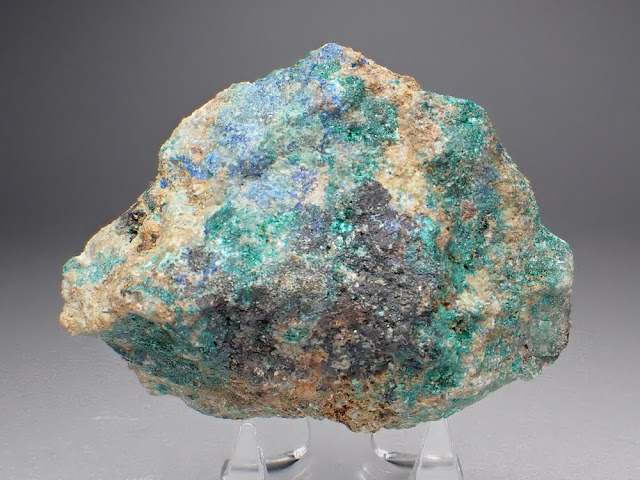尾去沢の藍銅鉱など Azurite etc. from Osarizawa
標本幅 width: 57 mm / 重さ weight: 77 g
尾去沢鉱山の鉱脈の上部には銅や鉛の硫化鉱物が天水の影響により分解した結果、種々の二次鉱物に富んだ領域が発達している。これはそうした酸化帯(あるいは二次富鉱帯)の鉱石標本。付属した古いラベルによれば、青色の部分が藍銅鉱(Cu3(CO3)2(OH)2)、緑色の部分がブロシャン銅鉱(Cu4(SO4)(OH)6)のようだ。
藍銅鉱はほとんど塊状であるが、わずかに薄板状〜柱状の自形結晶がみられる。ブロシャン銅鉱は放射状に生える針状の結晶群があったりしてわかりやすい。茶色い部分は輝銅鉱とおもわれるが、はっきりしない。そもそもこういった2次鉱物の肉眼鑑定はわたしにはむずかしい。藍銅鉱と青鉛鉱とのちがいもぱっと見よくわからない。
This is a piece of secondary copper ores from the oxidized zone of the Osarizawa mine. An old label says the blue and green minerals are respectively azurite and brochantite, the former being almost massive with a few exception of minute tabular and prismatic crystals and the latter is easy to identify for its acicular shape. The brown part is probably chalcocite. It is difficult for me to tell the species of these secondary minerals. I am not certain whether it is azurite or linarite without the label.
An old label of Iwamoto Mineral Company, Tokyo. The paper quality and the historic characters suggest it was written in or before 1950s.
次も銅の二次鉱物からなる標本。
The next one is also from a similar oxidized zone in Osarizawa.
標本幅 width: 53 mm / 重さ weight: 89 g
これは詳しいラベルがないのでわたしの乏しい経験にもとづく推定でしかないが、まず四面体状の黄銅鉱の群晶があって、その一部が輝銅鉱化し、さらに表面が緑色透明で皮膜状の二次鉱物で覆われたものとおもわれる。ガラスみたいになって明瞭な結晶がみられないので鉱物種は断定しがたいが、ブロシャン銅鉱とかそのあたりの銅の硫酸塩だろう。黄銅鉱の結晶と結晶のあいだを埋める水色の部分は質感からして珪孔雀石(Cu2H2Si2O5(OH)4·nH2O)か。背景の黄銅鉱(輝銅鉱)に緑が映えて鮮やかな標本である。
Though it arrived to me without detailed description on the label, I guess that a group of tetrahedral chalcopyrite crystals partially became chalcocite and they were covered by some thin green glassy translucent minerals. The lightblue mineral between chalcopyrite tetrahedrons will be chrysocolla.
黄銅鉱(CuFeS2)が酸化・分解して硫黄が抜けきると最終的には自然銅(Cu)や赤銅鉱(Cu2O)ができる。そこまで至らずとも斑銅鉱(Cu5FeS4)とか輝銅鉱(Cu2S)なんかはもともとの黄銅鉱にくらべて銅成分が濃集しているので、重要な銅鉱石とみなされる。
尾去沢では輝銅鉱がある程度まとまって産出した。南部秀喜が 1940 年代に記述したところによると、尾去沢の輝銅鉱には、方鉛鉱がその結晶形状を保持したまま輝銅鉱化した、当初「ハリス鉱」と呼ばれていたタイプ、黄銅鉱が内部まで完全に輝銅鉱化した紫黒色、堅硬で光沢をもつタイプ、黄鉄鉱が輝銅鉱化した灰黒色、無光沢でもろい土状のタイプ、などがあった(「南部鉱物標本解説」復刻版、茨城県自然博物館編、1997)。また木下亀城「尾去沢鉱山」(地質調査所報告 119 号、1937)によると、輝銅鉱は鉱床南部の赤沢遠丁ヒ、紫ヒの上一番〜二番坑道あたりに多産し、とくに紫ヒの名前は切羽が紫黒色に輝いて見えたことにちなんだものらしい(ヒは金偏に通で鉱脈のこと)。
斑銅鉱もみられ、木下によると大盛ヒと末広ヒの合流点付近や本ピなどで産出が多かったとある。また一般に鉱脈最上部の地表近くの部分(堀純郎「尾去沢鉱山およびその付近の地質・鉱床」(地質学雑誌、1940)によれば地表から 60 m ほどの部分)はほとんど褐鉄鉱のみからなる濾過流失帯(いわゆるヤケ)で有用金属に乏しかったという。
尾去沢は鉱床の規模が大きく、さまざまな種類の鉱物を産出した。南部の言葉を借りれば尾去沢は「さながら鉱床博物館」だった。
The Osarizawa mine produced nonprimary chalcocite to some extent. As Nanbu Hideki described in 1940s, there were several types such as pseudomorph after galena which was once misunderstood as "Harrisite" but now recognized as djurleite, a hard type altered from chalcopyrite with purple-black luster, and a gray-black earthy type altered from pyrite. Kinoshita Kameki wrote that chalcocite was mainly produced from the first and second upper levels of the Encho and Murasaki veins in the southern Akasawa area. The Murasaki ("purple" in Japanese) vein was named after the purple color of its working face. Bornite was also mined in Osarizawa, particularly from the intersection of the Taisei and Suehiro veins and from the Hon vein. As Nanbu wrote, Osarizawa was a kind of natural mineral museum.
参考
- 鉱山跡の探訪記。 Visit Report. #1 #2
- すでに紹介済みの自然銅 Native Copper と孔雀石 Malachite の標本。
- 一般に輝銅鉱(Cu2S)といわれているものは、しばしば方輝銅鉱(digenite Cu9S5)やデュルレ鉱(djurleite Cu31S16)を含む。色合いが微妙に異なるらしいが一般に肉眼での判別はむずかしい。往時ハリス鉱と呼ばれていた方鉛鉱後の仮晶は、主にデュルレ鉱からなることがわかっている。
- 秋田大学鉱業博物館所蔵の藍銅鉱標本。尾去沢鉱山産出。
Azurite from the Osarizawa mine displayed at Mineral Industry Museum of Akita University.標本の幅は 13 cm くらい。
About 13 cm in width. - 鹿角市鉱山歴史館所蔵の標本。
Secondary copper minerals displayed at Kazuno City Museum of Mining and History.赤銅鉱(大盛ヒ上二坑)と輝銅鉱(紫ヒ上四坑)。
Cuprite (upper second level of Taisei vein) and chalcocite (upper fourth level of Murasaki vein)胆礬と藍銅鉱(卯酉ヒ上四坑)。
Chalcanthite with azutite (upper fourth level of Utori vein). - 鹿角市鉱山歴史館の壁面に掲げられている尾去沢鉱山鉱床断面図。
A cross section of the ore deposit of the Osarizawa mine displayed at Kazuno City Museum of Mining and History.水平坑道は 30 m おきに掘られた。青字はわたしが書き込んだ。
The horizontal tunnels were situated every 30 m. The blue words were written by me. - 木下亀城「尾去沢鉱山」(地質調査所報告 119 号、1937)より「尾去沢鉱山坑内外図」。
A map of the Osarizawa Mine from Kameki Kinoshita, The Osarizawa Mine, Imperial Geological Survey of Japan Report No.119, 1937.白字はわたしが書き込んだ。
The white words were written by me.










